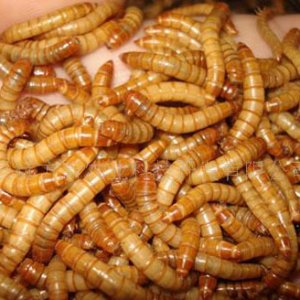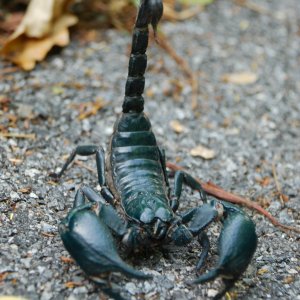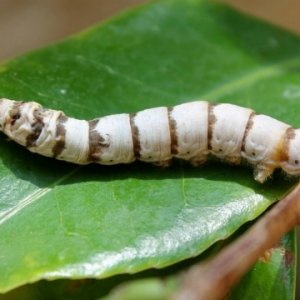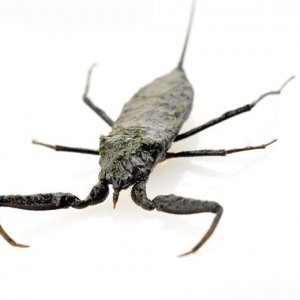Survival Skills: A Complete Guide to Edible Insects – Part 2
 Survival Skills: A Complete Guide to Edible Insects – Part 2
thegearhunt.com
Survival Skills: A Complete Guide to Edible Insects – Part 2
thegearhunt.com
Bugs might not seem to be the ideal for us as Americans, but entomophagy (eating insects) is actually quite a common thing in African and Asian countries, and even down under in Australia. While we might think it more than a bit off-putting to cook and eat bugs, people around the world have put prejudices like these aside and now regularly eat the insects for their nutritional value.
Take caterpillars for example, pound for pound, they offer more protein than minced beef. Going beyond that, there have been studies that have shown that some larvae and insects are actually quite a bit more nutritious than any of our typical foods.
Beef provides us with 200 – 300 calories for each 100 grams (this will vary depending on the level of fat), but for 100 grams of live termites, you get about 350 calories. The larvae of moths are also good to eat and provide about 265 calories for each 100 grams. These are also a great choice for when you want a lot of protein quickly. They are normally about 63% protein!
You might be thinking that the beef is much tastier than moth larvae or caterpillars, but you might be a bit surprised to hear that a lot of people would disagree with you. People who eat them say that they are more than a bit tasty when they are cooked. There are insects out there that taste like cinnamon, lemongrass, and even apple pie.
If at any point you are forced to make a meal out of what you can find crawling or flying, don’t pass up good nutrients just because it is a foreign concept to eat insects. Try to get over it and view it as a learning experience. It really isn’t half bad.
We published an article a couple of months ago with some of the insects you can eat. Here is the other half of that article.
June Beetles
 These were eaten by Native Americans, who roasted them over coals – both as larvae and as adults. People who have eaten them say that the taste is that of buttery walnuts. It is thought that it is relatively safe to just harvest these right from the wild because there aren’t any inedible species in the areas where they are found. If you choose to do this, make sure that you are harvesting them from areas that haven’t had pesticides sprayed.
These were eaten by Native Americans, who roasted them over coals – both as larvae and as adults. People who have eaten them say that the taste is that of buttery walnuts. It is thought that it is relatively safe to just harvest these right from the wild because there aren’t any inedible species in the areas where they are found. If you choose to do this, make sure that you are harvesting them from areas that haven’t had pesticides sprayed.
Katydids
 Some people know katydids as bush crickets, but they are closer relatives to grasshoppers than to crickets. Just as with the grasshopper, the katydid is eaten in many places where they are found. This includes Papua New Guinea, Southeast and East Asia, South America, and throughout Africa and India. A bug eater by the name of David Gracer says that katydids taste like a mix of croutons, shrimp, and chicken.
Some people know katydids as bush crickets, but they are closer relatives to grasshoppers than to crickets. Just as with the grasshopper, the katydid is eaten in many places where they are found. This includes Papua New Guinea, Southeast and East Asia, South America, and throughout Africa and India. A bug eater by the name of David Gracer says that katydids taste like a mix of croutons, shrimp, and chicken.
Locusts
 This is one more insect that is eaten where ever it is found. Locusts are in a special category with katydids, crickets, and grasshoppers as insects that the Bible acknowledges as being fit to eat. (Leviticus 11:22) This might have a lot to do with how popular they are. People say that they taste like a mix of sunflower seeds and shrimp, and that they can be even more delicious when they are fed sesame leaves.
This is one more insect that is eaten where ever it is found. Locusts are in a special category with katydids, crickets, and grasshoppers as insects that the Bible acknowledges as being fit to eat. (Leviticus 11:22) This might have a lot to do with how popular they are. People say that they taste like a mix of sunflower seeds and shrimp, and that they can be even more delicious when they are fed sesame leaves.
Longhorn Beetles
 This is a quite large family of beetles and consists of more than 20,000 species. This critter is named for its antennae, and these antennae can grow to lengths that are longer than the beetles’ actual bodies. This beetle is one of the more popular families of edible insects. They are eaten in nearly all of the same countries as katydids, but unlike those katydids, these are also eaten throughout most of Oceania.
This is a quite large family of beetles and consists of more than 20,000 species. This critter is named for its antennae, and these antennae can grow to lengths that are longer than the beetles’ actual bodies. This beetle is one of the more popular families of edible insects. They are eaten in nearly all of the same countries as katydids, but unlike those katydids, these are also eaten throughout most of Oceania.
Mayflies
 The adult mayfly has a very short lifespan – even shorter than that of damselflies and dragonflies. It lasts for only a single day. The Order Ephemeroptera, that they belong to, is named for the Greek phrase which means short lived. These insects get collected during the one day a year when they swarm and are eaten in Japan, China, Malawi, and Kenya.
The adult mayfly has a very short lifespan – even shorter than that of damselflies and dragonflies. It lasts for only a single day. The Order Ephemeroptera, that they belong to, is named for the Greek phrase which means short lived. These insects get collected during the one day a year when they swarm and are eaten in Japan, China, Malawi, and Kenya.
Meal Worms
 Many people in the entomophagy community call these the gateway bug because they are generally the first insect/bug that many people try. This is because it is easy to raise them, they are full of nutrition, and if you like roasted nuts, they taste superb. These aren’t truly worms though, but are actually the larvae from the darkling beetle, which is a small, black, flightless, non-biting beetle that is only about a centimeter in length and doesn’t mind being in crowded spaces. Also, it loves being in the dark.
Many people in the entomophagy community call these the gateway bug because they are generally the first insect/bug that many people try. This is because it is easy to raise them, they are full of nutrition, and if you like roasted nuts, they taste superb. These aren’t truly worms though, but are actually the larvae from the darkling beetle, which is a small, black, flightless, non-biting beetle that is only about a centimeter in length and doesn’t mind being in crowded spaces. Also, it loves being in the dark.
Mosquitos and Midges
 You might be more used to these feeding on you, but they are good to eat as well. They are both from the Order Diptera (flies) and are typically described by humans as nuisances. However, people in East Africa harvest then in nets as they swarm over the lakes there. Mexicans are known for serving mosquito eggs wrapped in tortillas with a bit of lime.
You might be more used to these feeding on you, but they are good to eat as well. They are both from the Order Diptera (flies) and are typically described by humans as nuisances. However, people in East Africa harvest then in nets as they swarm over the lakes there. Mexicans are known for serving mosquito eggs wrapped in tortillas with a bit of lime.
Mopane Worms
 This is also not really a worm, but instead, it is a caterpillar that is in the emperor moth species. Yes, you may remember the emperor moth from the last article, but these guys go into a category of their own because of their popularity in Southern Africa. Also, they are fed to many there as their first insect specifically for eating. They taste amazing.
This is also not really a worm, but instead, it is a caterpillar that is in the emperor moth species. Yes, you may remember the emperor moth from the last article, but these guys go into a category of their own because of their popularity in Southern Africa. Also, they are fed to many there as their first insect specifically for eating. They taste amazing.
Palm Weevils
 These are full of nutrition and even some essential fats, and because of this, it shouldn’t surprise you that they are one of the staple insects all across the globe. You will find them being served up in Papua New Guinea, South America, Southeast Asia, Western and Central Africa, and China. People say that when they are cooked the taste is akin to that of bacon. A Malaysian dish called Sago Delight that features these insects has many variations all throughout Asia.
These are full of nutrition and even some essential fats, and because of this, it shouldn’t surprise you that they are one of the staple insects all across the globe. You will find them being served up in Papua New Guinea, South America, Southeast Asia, Western and Central Africa, and China. People say that when they are cooked the taste is akin to that of bacon. A Malaysian dish called Sago Delight that features these insects has many variations all throughout Asia.
Rhinoceros Beetles
 Many people might know what the adult rhinoceros beetle looks like. Not surprisingly though, their larvae are much more edible than those hard exoskeletons on the adult versions. For this reason, it is typically their larvae that are eaten. People eat these all over the planet and the larvae are extremely nutritious. They are even said to be a possible significant form of protein for nations that might be impoverished in the future. A bit of trivia – Rhinoceros beetles are known as the strongest animals on the face of the earth. They can lift as much as 850 times what they weigh.
Many people might know what the adult rhinoceros beetle looks like. Not surprisingly though, their larvae are much more edible than those hard exoskeletons on the adult versions. For this reason, it is typically their larvae that are eaten. People eat these all over the planet and the larvae are extremely nutritious. They are even said to be a possible significant form of protein for nations that might be impoverished in the future. A bit of trivia – Rhinoceros beetles are known as the strongest animals on the face of the earth. They can lift as much as 850 times what they weigh.
Scorpions
 This might be the most intimidating entry on this list. However, scorpions taste a bit like shrimp, but they have a bit of a nutty flavor too. Anyone who has been around the night markets in Beijing might have at least a passing familiarity with scorpion on a stick. The large black ones cost unsuspecting tourists quite a bit.
This might be the most intimidating entry on this list. However, scorpions taste a bit like shrimp, but they have a bit of a nutty flavor too. Anyone who has been around the night markets in Beijing might have at least a passing familiarity with scorpion on a stick. The large black ones cost unsuspecting tourists quite a bit.
Silkworms
 Silkworms are one worm that come from a large family. However, that can be narrowed down to moths and butterflies. These are typically eaten in their pupal form, and are a by product of, you guessed it, the silk industry. They can be found being sold in the street markets of any country that produces silk. In Japan, China, and South Korea, this species is eaten, and it tastes a bit bland, sort of like tofu, but people spice them up a bit by marinating them in chili and garlic.
Silkworms are one worm that come from a large family. However, that can be narrowed down to moths and butterflies. These are typically eaten in their pupal form, and are a by product of, you guessed it, the silk industry. They can be found being sold in the street markets of any country that produces silk. In Japan, China, and South Korea, this species is eaten, and it tastes a bit bland, sort of like tofu, but people spice them up a bit by marinating them in chili and garlic.
Stag Beetles
 These beetles are named for the mandibles that the males of the species use to battle each other when it comes time for mating. In Europe, they are the largest land-dwelling insect, but they aren’t typically eaten there. However, they are quite popular menu items in Madagascar, Papua New Guinea, Japan, Malaysia, India, Ecuador, and Mexico.
These beetles are named for the mandibles that the males of the species use to battle each other when it comes time for mating. In Europe, they are the largest land-dwelling insect, but they aren’t typically eaten there. However, they are quite popular menu items in Madagascar, Papua New Guinea, Japan, Malaysia, India, Ecuador, and Mexico.
Stick Insects
 These are more commonly known as walking sticks and are members of the Phasmatodea family. These are another true bug. They aren’t too popular when it comes to insects you can eat, but that is because they are only really eaten in Papua New Guinea and Malaysia. They are said to taste like trees, but given what they eat, this should come as no surprise.
These are more commonly known as walking sticks and are members of the Phasmatodea family. These are another true bug. They aren’t too popular when it comes to insects you can eat, but that is because they are only really eaten in Papua New Guinea and Malaysia. They are said to taste like trees, but given what they eat, this should come as no surprise.
Stink Bugs
 This is another of the true bugs. This bug makes up a quite large group of bugs that people in South Africa, South America, India, and Southeast Asia eat. Some people say they are sweet and tangy while others say they are bitter, but they are generally eaten raw because some of them seem to be able to survive being cooked!
This is another of the true bugs. This bug makes up a quite large group of bugs that people in South Africa, South America, India, and Southeast Asia eat. Some people say they are sweet and tangy while others say they are bitter, but they are generally eaten raw because some of them seem to be able to survive being cooked!
Super Worms
 Just as it is with mealworms, these are not true worms. In fact, they are close relatives to the mealworms. They taste a bit similar too but tend to be a bit blander. You can find people eating these all over the world, but they are especially popular in Venezuela and Mexico.
Just as it is with mealworms, these are not true worms. In fact, they are close relatives to the mealworms. They taste a bit similar too but tend to be a bit blander. You can find people eating these all over the world, but they are especially popular in Venezuela and Mexico.
Tarantulas
 These are considered to be quite a delicacy in Southeast Asia. They are critically important to the people who live in the poorer areas of Cambodia. They are hunted and then dug from their holes in order to provide a source of protein for the people who eat them. If it wasn’t for these critters, the people there would subsist on generally nothing but rice. You can see these spider hunters in the BBC documentary called Can Edible Insects Save the World? The tarantulas tend to be eaten whole and people say that they taste a bit like a soft shell crab.
These are considered to be quite a delicacy in Southeast Asia. They are critically important to the people who live in the poorer areas of Cambodia. They are hunted and then dug from their holes in order to provide a source of protein for the people who eat them. If it wasn’t for these critters, the people there would subsist on generally nothing but rice. You can see these spider hunters in the BBC documentary called Can Edible Insects Save the World? The tarantulas tend to be eaten whole and people say that they taste a bit like a soft shell crab.
Termites
 Termites are critters that are full of protein and they also have a full profile of essential amino acids. Because of this, it isn’t surprising that they are consumed throughout Southeast Asia and Africa. People harvest them right from the ground or collect them when they transform into winged creatures and swarm trying to locate mates. The taste will depend on what species they are. Some taste like mint while others have a nutty taste.
Termites are critters that are full of protein and they also have a full profile of essential amino acids. Because of this, it isn’t surprising that they are consumed throughout Southeast Asia and Africa. People harvest them right from the ground or collect them when they transform into winged creatures and swarm trying to locate mates. The taste will depend on what species they are. Some taste like mint while others have a nutty taste.
Tiger Beetles
 For those who geek out about insects, this one is really cool. This beetle is named for the method it uses to hunt. The adults have a bit of speed both in the air and on the ground. The larvae are predators too, but they ambush their prey from the burrows they live in. Even so, neither the larvae nor the adults are quick enough to not get caught by the Mexicans who want to eat them.
For those who geek out about insects, this one is really cool. This beetle is named for the method it uses to hunt. The adults have a bit of speed both in the air and on the ground. The larvae are predators too, but they ambush their prey from the burrows they live in. Even so, neither the larvae nor the adults are quick enough to not get caught by the Mexicans who want to eat them.
Wasps
 Wasps are a common meal in the Congo, Australia, Indonesia, Myanmar, Thailand, and China. People say they taste both buttery and earthy. If you pay attention to the sayings of Japan’s Emperor Hirohito, they are very good when served with boiled rice, soy sauce, and sugar.
Wasps are a common meal in the Congo, Australia, Indonesia, Myanmar, Thailand, and China. People say they taste both buttery and earthy. If you pay attention to the sayings of Japan’s Emperor Hirohito, they are very good when served with boiled rice, soy sauce, and sugar.
Water Boatmen
 These critters might look like they are beetles, but they fall into the true bug category. They are eaten mainly in Mexico. These are aquatic bugs that live in slow streams and in ponds. Most of them are vegetarian, and this is a rather unusual trait for water bugs.
These critters might look like they are beetles, but they fall into the true bug category. They are eaten mainly in Mexico. These are aquatic bugs that live in slow streams and in ponds. Most of them are vegetarian, and this is a rather unusual trait for water bugs.
Water Scorpions
 These aren’t related to the land scorpions in anything other than their appearance. Water scorpions are also true bugs. However, they are also quite ferocious predators and they ambush their prey. This might be anything from tadpoles to the larvae of insects. These are eaten in the Congo, Madagascar, Japan, Indonesia, Thailand, and Laos.
These aren’t related to the land scorpions in anything other than their appearance. Water scorpions are also true bugs. However, they are also quite ferocious predators and they ambush their prey. This might be anything from tadpoles to the larvae of insects. These are eaten in the Congo, Madagascar, Japan, Indonesia, Thailand, and Laos.
Waxworms
 These are the caterpillars of a moth known as the wax moth. Sometimes these are called bee moths due to the fact that they actually live in beehives and they eat nearly everything in them, aside from adult bees. People in Brazil, Mexico, Japan, and China eat them. When people farm them, they are fed honey and bran. They are said to taste like a cross between enoki mushrooms and pine nuts.
These are the caterpillars of a moth known as the wax moth. Sometimes these are called bee moths due to the fact that they actually live in beehives and they eat nearly everything in them, aside from adult bees. People in Brazil, Mexico, Japan, and China eat them. When people farm them, they are fed honey and bran. They are said to taste like a cross between enoki mushrooms and pine nuts.
Witchetty Grubs
 These are a favorite of Australian Aborigines. People say that they taste like a mild mozzarella and scrambled eggs with a nutty flavor, and all of it wrapped up neatly in a phyllo dough pastry. For those people who enjoy foraging for bugs, they are an excellent source of fat content and high in protein.
These are a favorite of Australian Aborigines. People say that they taste like a mild mozzarella and scrambled eggs with a nutty flavor, and all of it wrapped up neatly in a phyllo dough pastry. For those people who enjoy foraging for bugs, they are an excellent source of fat content and high in protein.
Hopefully, by now, you will have a good idea of what insects you can eat if you are ever stranded in the wild.
Sources
- 4ento, Edible Insects Which Insects Can You Eat?
- Health Prep, 9 Edible Insects
- Secrets of Survival, The Top Ten Edible Insects in North America
- Health Prep, Bugging to Eat; Everything to Know About Entomophagy
















